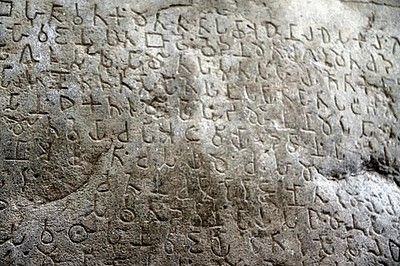The Yaudheyas occupy a significant place in the annals of ancient Indian history, spanning a chronology that stretches from as early as 500 BCE to around 1200 CE. Renowned for their martial prowess and extensive influence, the Yaudheyas are referenced in numerous classical texts and inscriptions, reflecting their enduring presence and power in the Indian subcontinent.
Historical Mentions and Literary References
The Yaudheyas find mention in some of the most authoritative Sanskrit works of ancient India, including Panini’s Ashtadhyayi and the Ganapatha. Panini, who authored the earliest known treatise on Sanskrit grammar in the 4th century BCE, incorporated references to the Yaudheyas, indicating their recognition in intellectual and social domains of the time. Apart from Panini, the Yaudheyas are also cited in esteemed texts such as the Mahabharata, Mahamayuri, Brihatsamhita, various Puranas, the Chandravyakarana, and the Kashika.
The Mahabharata, the great Indian epic, alludes to numerous clans and tribes contemporaneous to the epic’s setting, situating the Yaudheyas within the larger cultural framework of ancient India. The Brihat Samhita, the encyclopedic treatise by Varahamihira, places them in the northern division of India, consolidating their identity as a prominent power known to ancient scholars.
Chronological Span and Period of Influence
The Yaudheya clan is assumed to have existed from as early as 500 BCE, with their influence peaking between roughly 200 BCE and 400 CE. This period marks the heyday of their political and military power, during which they exerted considerable control over large swathes of territory in north-western India. Even beyond this zenith, they continued to be significant players until approximately 1200 CE, demonstrating remarkable longevity as a political entity.
Genealogy and Mythological Descent
Ancient sources attribute the lineage of the Yaudheyas to two mythological ancestors—Usinara and Nrigu. These figures are traditionally credited with founding prominent warrior clans and serve to legitimize the Yaudheyas’ claim to martial nobility. This mytho-historical descent aligns with the clan’s self-image as an indomitable warrior community, emphasizing their proud origins and role as protectors of dharma and regional sovereignty.
Geographical Extent
The core realm of the Yaudheyas constituted the southeastern parts of Punjab and Rajasthan, encompassing territories that correspond to modern-day northwestern India and parts of Pakistan. Key locations associated with the Yaudheyas include:
- Western regions: Around the Sutlej River, Depalpur, Satgarha, Ajundhan, Kahror, and Multan.
- Eastern regions: Bhatner, Abohar, Sirsa, Hansi, Panipat, and Sonipat.
- Northern regions: Kangra and adjacent hill territories.
This broad geographical spread reveals the extensive influence of the Yaudheyas, who controlled vital trade routes and strategic military locations in the northern Indian subcontinent.
Political and Military Prowess
The military might of the Yaudheyas was well recognized by contemporaneous rulers and chroniclers. The Junagadh rock inscription of Rudradaman, a prominent Western Kshatrapa ruler of the 2nd century CE, alludes to the martial capabilities of the Yaudheyas. Furthermore, the Allahabad pillar inscription of the great Gupta emperor Samudragupta also mentions the Yaudheyas, indicating that they were among the significant powers the emperor encountered during his conquest campaigns.
The mention in these inscriptions not only attests to the Yaudheyas’ independent status but also reflects their capacity to mount formidable military resistance to imperial ambitions, thereby asserting their political sovereignty.
Numismatic Evidence
One of the most tangible evidences of the Yaudheyas’ existence and influence is derived from their prolific coinage. A vast number of coins and coin-moulds attributed to the Yaudheyas have been unearthed across the various regions under their control. These coins exhibit distinct iconography, predominantly featuring deities such as Brahmanyadeva and Karttikeya.
The emphasis on Karttikeya, the Hindu god of war, on many of their coins underscores the martial ethos that defined the clan. This numismatic legacy not only provides insights into their religious leanings but also serves as an indicator of their economic stability and organized minting practices.
Religious Affiliation and Cultural Identity
The Yaudheyas were staunch adherents of Hinduism, and their religious philosophy was closely tied to their warrior status. The worship of Karttikeya, a deity associated with victory and warfare, exemplifies their spiritual connection to martial valor. This religious identity further cemented their status as protectors and warriors in the socio-political landscape of the time.
Religious texts like the Mahamayuri and various Puranasreflect references to warrior clans akin to the Yaudheyas, indicating their role in the religious and cultural narrative of ancient India. Such associations reinforced their claims to both temporal power and divine sanction.
Conclusion
The Yaudheyas, a prominent warrior clan from early historic to medieval times, are referenced in texts ranging from Panini’s Ashtadhyayi to the Mahabharata and inscriptions of Rudradaman and Samudragupta. Dominating southeastern Punjab and Rajasthan, they were known for their military strength, autonomy, and unique coinage. Devout Hindus, particularly worshippers of Karthikeya, the Yaudheyas integrated martial prowess with religious devotion, leaving a significant mark on ancient India’s political and cultural history.
